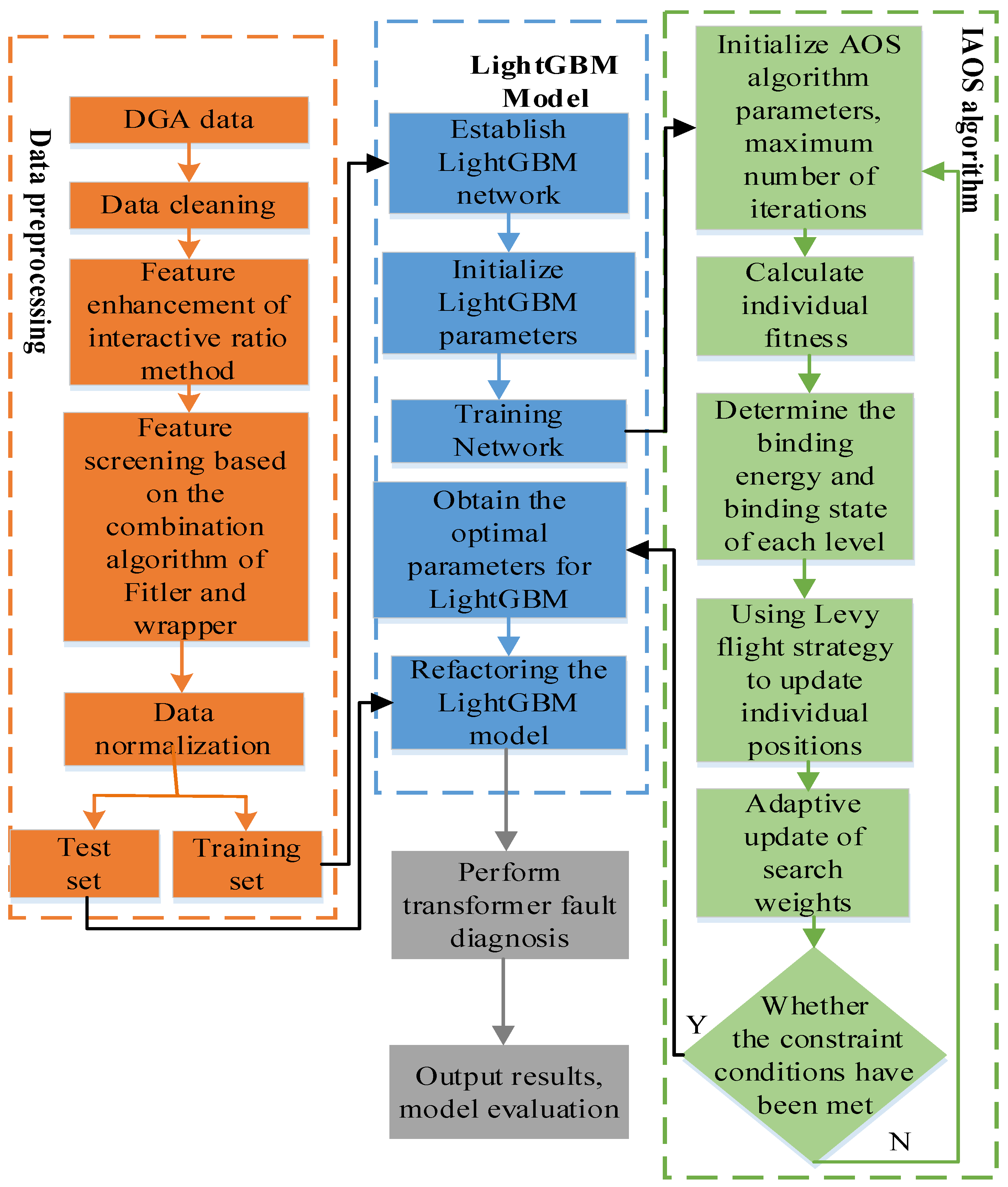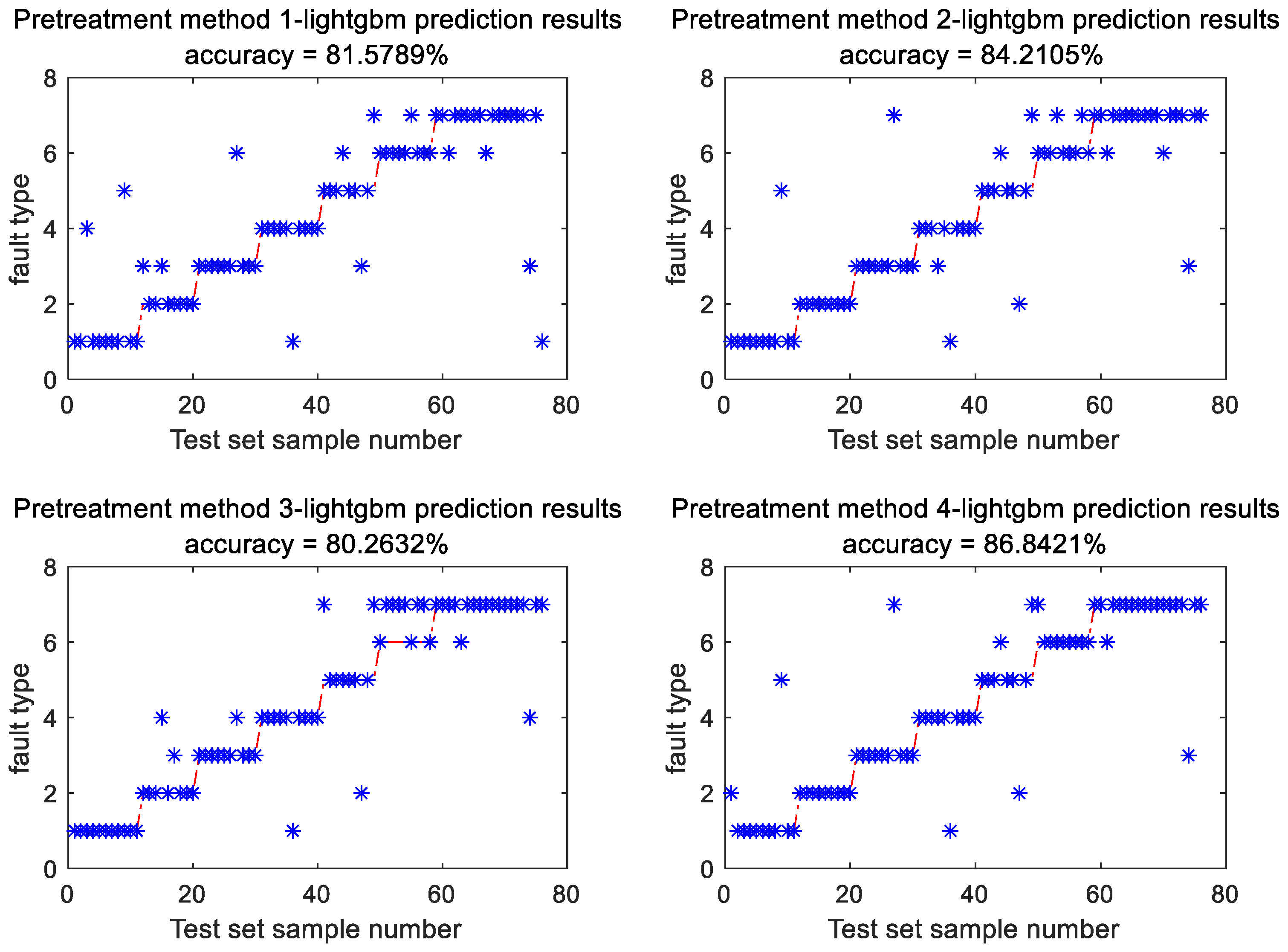Transformer Fault Diagnosis Utilizing Feature Extraction and Ensemble Learning Model
Abstract
1. Introduction
2. Algorithm Principle
2.1. IAOS Algorithm Principle
2.1.1. AOS Algorithm
2.1.2. IAOS Algorithm
2.2. LightGBM Algorithm Principle
3. Transformer Fault Diagnosis Model
- A series of data preprocessing steps were performed on DGA sample data, including data cleaning, feature enhancement through the interactive ratio method, feature selection using a combination of Filter and Wrapper algorithms, and normalization;
- The preprocessed data were randomly divided into a training set and a testing set in a specified proportion;
- The hyperparameters of LightGBM model were set to IAOS individuals, and the parameters for both IAOS and LightGBM were initialized;
- The training set was used as input for training, and LightGBM parameters were optimized using IAOS algorithm;
- The model was evaluated with the validation set, and the parameters were adjusted accordingly;
- It was determined whether the training was completed;
- The optimal model was output, the final model was tested with the testing set, diagnostic results were generated, and the model was evaluated.
4. Case Study and Analysis
4.1. Data Acquisition
4.2. Data Preprocessing
4.2.1. Data Cleaning
- The missing value is checked and filled with the minimum value; because the subsequent feature engineering needs to perform the feature ratio, if the missing value is filled with 0, 0 as the denominator will produce an abnormal value, so the missing value is filled with a fixed value of 0.01. Some data in the original data are zero, and the feature attributes added by the ratio method have the case that the divisor is zero, so abnormal data will be generated. The processing methods of abnormal data are Pauta criterion and fixed value filling. The DGA data are too scattered and the data level is quite different. The Pauta criterion will eliminate most of the data and the Pauta criterion is not applicable to DGA data. Therefore, the fixed value (0.01) filling method is used to process the abnormal data.
- Outliers are identified and processed to reduce their impact on data feature representation. These outliers are due to abnormal data sensor transmission, resulting in an abnormal data level, which can be replaced by its mean.
- The data type is converted to float for subsequent analysis and processing.
- Duplicate data are identified and removed to avoid errors during analysis and processing.
- Data are uniformly converted to the same numerical range to prevent misunderstandings between data of different specifications.
- Data are integrated into a single dataset, ensuring correct connections between different data points.
- The post-cleaning DGA data are illustrated in Figure 3.
4.2.2. Feature Enhancement Using Interactive Ratio Method
4.2.3. Feature Selection Using Combined Filter and Wrapper Methods
4.2.4. Data Normalization
4.3. Transformer Fault Diagnosis Results and Analysis
4.3.1. Fault Diagnosis Based on LightGBM Model
4.3.2. Fault Diagnosis Results Using Different Feature Processing Methods
- Preprocessing method 1: features constructed without the encoding ratio, combined with original features;
- Preprocessing method 2: features constructed using IEC ratio, Rogers ratio, and three-ratio method, combined with original features;
- Preprocessing method 3: raw data without any feature construction;
- Preprocessing method 4: feature extraction method proposed in this paper;
- LightGBM model was employed to classify data processed using four different preprocessing methods, and the diagnostic results of the testing set are illustrated in Figure 6.
4.3.3. Impact of Different Optimization Algorithms on Model
5. Conclusions
- Following preprocessing with the proposed feature extraction method, the data were input into LightGBM model for fault diagnosis, achieving an accuracy of 86.84%, which represents an improvement of 6.58% over the unprocessed data;
- Upon applying the IAOS optimization algorithm for model parameter tuning, the model’s accuracy increased to 93.42%, reflecting a further improvement of 6.58%;
- The IAOS algorithm proposed for parameter optimization enhanced the model’s accuracy by 1.32% compared to the original AOS algorithm.
Author Contributions
Funding
Institutional Review Board Statement
Informed Consent Statement
Data Availability Statement
Conflicts of Interest
References
- Xie, G.M.; Wangm, J.L. Transformer fault identification method based on hybrid sampling and IHBA-SVM. J. Electr. Measur. Instrument. 2022, 36, 77–85. [Google Scholar]
- Yang, L.; Gao, L.; Luo, X.; Hao, Y.; Zhang, Z.; Jin, Y.; Zhang, J. An Improved Method for Fault Diagnosis of Oil-Immersed Transformers Based on Simulation Test Platform. IEEE Trans. Dielectr. Electr. Insul. 2024. [Google Scholar] [CrossRef]
- Taha, B.I.; Mansour, A.D. Novel Power Transformer Fault Diagnosis Using Optimized Machine Learning Methods. Intell. Autom. Soft Comp. 2021, 28, 739–752. [Google Scholar] [CrossRef]
- Chen, T.; Chen, W.D.; Li, X.S.; Chen, Z. Transformer fault prediction based on analysis of dissolved gas in oil. Electr. Measur. Technol. 2021, 44, 25–31. [Google Scholar]
- Kirkbas, A.; Demircali, A.; Koroglu, S.; Kizilkaya, A. Fault diagnosis of oil-immersed power transformers using common vector approach. Electr. Power Syst. Res. 2020, 184, 106346. [Google Scholar] [CrossRef]
- Qu, Y.H.; Zhao, H.S.; Ma, L.B.; Zhao, S.C.; Mi, Z.Q. Multi-Depth Neural Network Synthesis Method for Power Transformer Fault Identification. Chin. Soc. Electr. Eng. 2021, 41, 8223–8231. [Google Scholar]
- Jiang, Y.J.; Tang, X.F.; Tang, D.C.; Zhao, M.Y.; Jing, B.Q. A transformer fault prediction method based on the fusion of grey theory and IEC triple ratio. J. Guilin Univ. Aerosp. Technol. 2024, 29, 38–45. [Google Scholar]
- Hoballah, A.; Mansour, D.E.A.; Taha, I.B.M. Hybrid grey wolf optimizer for transformer fault diagnosis using dissolved gases considering uncertainty in measurements. IEEE Access 2020, 8, 139176–139187. [Google Scholar] [CrossRef]
- Yang, X.; Chen, W.; Li, A.; Yang, C.; Xie, Z.; Dong, H. BA-PNN-based methods for power transformer fault diagnosis. Adv. Eng. Inform. 2019, 39, 178–185. [Google Scholar] [CrossRef]
- Yan, C.; Li, M.; Liu, W. Transformer fault diagnosis based on BP-Adaboost and PNN series connection. Math. Probl. Eng. 2019, 9, 1019845. [Google Scholar] [CrossRef]
- Wu, G.; Yao, J.; Guan, M.; Zhu, X.; Wu, K.; Li, H.; Song, S. Power transformer fault diagnosis based on DBSCAN. J. Wuhan Univ. 2021, 54, 1172–1179. [Google Scholar]
- An, G.; Shi, Z.; Ma, S.; Han, X.; Du, Z.; Zhao, C. Woa-svm transformer fault diagnosis based on RF feature optimization. High Volt. Appar. 2022, 58, 171–178. [Google Scholar]
- Rao, S.; Zou, G.; Yang, S.; Barmada, S. A feature selection and ensemble learning based methodology for transformer fault diagnosis. Appl. Soft Comput. 2024, 150, 111072. [Google Scholar] [CrossRef]
- Zhang, Y.W.; Feng, B.; Chen, Y.; Liao, W.H.; Guo, C.X. Fault diagnosis method for oil-immersed transformer based on XGBoost optimized by genetic algorithm. Electr. Power Autom. Equip. 2021, 41, 200–206. [Google Scholar]
- Wang, Y.H.; Wang, Z.Z. Transformer fault identification method based on RFRFE and ISSA-XGBoost. J. Electr. Measur. Instrum. 2021, 35, 142–150. [Google Scholar]
- Zhang, M.; Chen, W.; Zhang, Y.; Liu, F.; Yu, D.; Zhang, C.; Gao, L. Fault diagnosis of oil-immersed power transformer based on difference-mutation brain storm optimized Catboost model. IEEE Access 2021, 9, 168767–168782. [Google Scholar] [CrossRef]
- Hu, L.Y.; Jiang, W.B.; Li, Y.T. Fault diagnosis for wind turbine based on lightgbm. Acta Energiae Solaris Sin. 2021, 42, 255–259. [Google Scholar]
- Xu, B.Q.; He, J.C.; Sun, L.L. Fault detection method of cage asynchronous motor based on stacked autoencoder and improved LightGBM algorithm. Electr. Mach. Control 2021, 25, 29–36. [Google Scholar]
- Azizi, M. Atomic orbital search: A novel metaheuristic algorithm. Appl. Math. Model. 2021, 93, 657–683. [Google Scholar] [CrossRef]
- Han, X.; Wang, X.Y.; Han, S.; Zhang, Y.T.; Wang, J.Y. Ensemble learning method for large-scale power transformer status evaluation based on imbalanced data. Power Syst. Technol. 2021, 47, 107–114. [Google Scholar]
- GB-T 7252-2016; Guidelines for Analysis and Determination of Dissolved Gases in Transformer Oil. China Standard Press: Beijing, China, 2016.
- Yu, S.; Hu, D.; Tang, C.; Zhang, C.M.; Tan, W.M. MSSA-SVM transformer fault diagnosis method based on TLR-ADASYN balanced data set. High Volt. Eng. 2021, 47, 3845–3853. [Google Scholar]
- Liu, Z.; He, W.; Liu, H.; Luo, L.; Zhang, D.; Niu, B. Fault identification for power transformer based on dissolved gas in oil data using sparse convolutional neural networks. IET Gener. Transm. Distrib. 2023, 18, 517–529. [Google Scholar] [CrossRef]
- Gong, Z.W.Y.; Rao, T.; Wang, G.; Li, Z.; Luo, Z.; Zhu, J.X.; Peng, J.; Yu, H.; Cao, Z.G. Fault diagnosis method of transformer based on improved particle swarm optimization XGBoost. High Volt. Appar. 2023, 59, 61–69. [Google Scholar]








| Fault Type | Status Code | Number of Training Sets | Number of Testing Sets |
|---|---|---|---|
| Normal operation | 1 | 43 | 11 |
| Low-temperature overheating | 2 | 36 | 9 |
| Medium-temperature overheating | 3 | 41 | 10 |
| High-temperature overheating | 4 | 39 | 10 |
| Partial discharge | 5 | 36 | 9 |
| Low-energy discharge | 6 | 37 | 9 |
| High-energy discharge | 7 | 73 | 18 |
| Fault Type | Testing Set | TP | FP | FN |
|---|---|---|---|---|
| Normal operation | 11 | 9 | 1 | 2 |
| Low temperature overheating | 9 | 9 | 2 | 0 |
| Medium temperature overheating | 10 | 9 | 1 | 1 |
| High temperature overheating | 10 | 9 | 0 | 1 |
| Partial discharge | 9 | 6 | 1 | 3 |
| Low energy discharge | 9 | 8 | 2 | 1 |
| High energy discharge | 18 | 16 | 3 | 2 |
| Total | 76 | 66 | 10 | 10 |
| Highest Accuracy | Lowest Accuracy | Average Accuracy | |
|---|---|---|---|
| Preprocessing 1 | 88.16% | 75% | 82.24% |
| Preprocessing 2 | 89.47% | 77.63% | 84.08% |
| Preprocessing 3 | 85.53% | 75% | 80.79% |
| Preprocessing 4 | 92.11% | 80.26% | 86.32% |
Disclaimer/Publisher’s Note: The statements, opinions and data contained in all publications are solely those of the individual author(s) and contributor(s) and not of MDPI and/or the editor(s). MDPI and/or the editor(s) disclaim responsibility for any injury to people or property resulting from any ideas, methods, instructions or products referred to in the content. |
© 2024 by the authors. Licensee MDPI, Basel, Switzerland. This article is an open access article distributed under the terms and conditions of the Creative Commons Attribution (CC BY) license (https://creativecommons.org/licenses/by/4.0/).
Share and Cite
Xu, G.; Zhang, M.; Chen, W.; Wang, Z. Transformer Fault Diagnosis Utilizing Feature Extraction and Ensemble Learning Model. Information 2024, 15, 561. https://doi.org/10.3390/info15090561
Xu G, Zhang M, Chen W, Wang Z. Transformer Fault Diagnosis Utilizing Feature Extraction and Ensemble Learning Model. Information. 2024; 15(9):561. https://doi.org/10.3390/info15090561
Chicago/Turabian StyleXu, Gonglin, Mei Zhang, Wanli Chen, and Zhihui Wang. 2024. "Transformer Fault Diagnosis Utilizing Feature Extraction and Ensemble Learning Model" Information 15, no. 9: 561. https://doi.org/10.3390/info15090561
APA StyleXu, G., Zhang, M., Chen, W., & Wang, Z. (2024). Transformer Fault Diagnosis Utilizing Feature Extraction and Ensemble Learning Model. Information, 15(9), 561. https://doi.org/10.3390/info15090561





